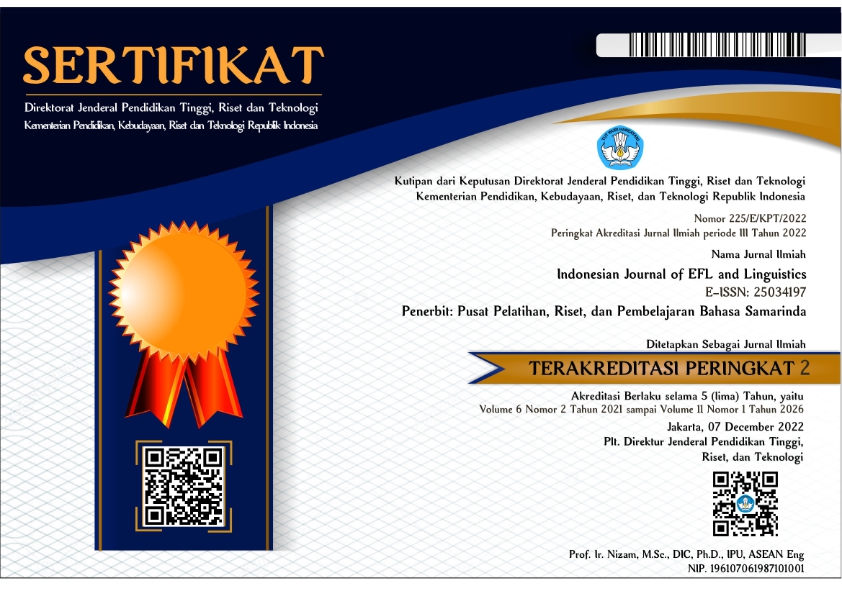CALL in Post-Method Era
Abstract
This paper touches on the influx of technology in language learning and teaching with a focus on the post-method era. Scrutinizing this phenomenon within the framework of Computer-Assisted Language Learning (CALL) shows how technology has stimulated a transformation of language pedagogy from the traditional teacher-centered and text-bound classrooms to student-centered and interactive paradigms. While the former paradigm is based on methodology, the latter is guided by principled eclecticism in which teachers make use of a set of macro-strategies so as to make decisions while teaching, instead of reliance on methods that dictate ‘how to teach’. The teaching principles capitalize on teachers’ sensitivity to local contexts rather than general methods. Though CALL has been mooted as panacea for ELT flaws in the method and post-method eras, it is not a one-size-fits-all model. Due to changeable and diversified technological innovations, it is impractical to adopt an electronic device or application for all contexts. Accordingly, the post-method pedagogy puts the onus on language teachers to make informed choices that best fit the particularity of their teaching situations.Â
References
Akbari, R. (2008). Postmethod discourse and practice. TESOL Quarterly, 42, 641â‚‹652. Doi:10.1002/j.1545-7249.2008.tb00152.x
Blake, R. (2016). Technology and the four skills. Language Learning & Technology, 20(2), 129-142.
Brett, P. (2001). The design, implementation and evaluation of a multimedia application for second language listening comprehension (Doctoral dissertation). University of Wolverhampton, Wolverhampton, UK.
Chapelle, C. (2005). Interactionist SLA theory in CALL research. In J. Egbert and G. Petrie, (Eds.), Research perspectives on CALL (pp. 53-64). Mahwah, NJ: Laurence Erlbaum Associates.
Chouit, D., Nfissi, A., Laabidi, H. (2017). Exploring the correlation between professors’ use of ICT in teaching and the levels of institutional support. JELTL (Journal of English Language Teaching and Linguistics), 2(1), 47-63. doi:http://dx.doi.org/10.21462/jeltl.v2i1.39
Chun, D., Kern, R. & Smith, B. (2016), Technology in language use, language teaching, and language learning. The Modern Language Journal, 100, 64–80. DOI: 10.1111/modl.12302
Crystal, D. (2008).Texting. ELT J, 62 (1), 77â‚‹83. DOI:10.1093/elt/ccm08
Davies, G., Otto, S., & Rüschoff, B. (2013). Historical perspectives on CALL. In M.Thomas, H. Reinders & M. Warschauer (Eds.), Contemporary computer-assisted language learning (pp. 19-35). London: Bloomsbury Academic.
Egbert, J. & Hansonâ‚‹Smith, E. (Eds.) (2000(.CALL environments: Research, practice, and critical issues. TESOL-EJ, 4(3). Retrieved from http://www.teslej.org/wordpress/issues/volume4/ej15/ej15r16/
Farivar, A. & Rahimi, A. (2015). The impact of CALL on Iranian EFL learners’ autonomy. Procedia- Social and Behavioral Sciences, 192, 644-649. Doi: 10.1016/j.sbspro.2015.06.112
Garrett, N. (2009). Technology in the service of language learning: Trends and issues. The Modern Language Journal, 93, 697-718. DOI: 10.1111/j.1540-4781.2009.00968.x
Gündüz, N. (2005). Computer assisted language learning (CALL). Journal of Language and Linguistic Studies, 1(2), 193₋214.
Jarvis, H. & Achilleos, M. (2013). From computer assisted language learning (CALL) to mobile assisted language use (MALU). The Electronic Journal for English as a Second Language(TESL-EJ),16(4), 1â‚‹18.
Khaloufi, A. & Laabidi, H. (2017). An examination of the impact of computer skills on the effective use of ICT in the classroom. Indonesian Journal of EFL and Linguistics, 2(1), 53-69. DOI: 10.21462/ijefll.v2i1.29
Kenning, M. & Kenning, M. J. (1990). Computers and language learning: Current theory and practice. New York: Ellis Horwood.
Kern, R. (2006). Perspectives on technology in learning and teaching
languages. TESOL Quarterly, 40(1), 183â‚‹210. Retrieved from http://dx.doi.org/10.2307/40264516
Kumaravadivelu, B. (2001). Toward a Postmethod Pedagogy. TESOL Quarterly, 35, 537â‚‹560. Doi:10.2307/3588427
Kumaravadivelu, B. (2006). Understanding language teaching: From method to postmethod. Lawrence Erlbaum Associates, Publishers Mahwah, New Jersey.
Laabidi, H. (2016). The effect of age on English professors’ integration of the new technologies in teaching. IJELTAL (Indonesian Journal of English Language Teaching and Applied Linguistics), 1(1), 63-74.
Lewis, G. (2015). Reality check: Evaluating the impact of technology in language teaching 10 years after Web 2.0. Plenary Session 2 of the 5th Bilgi University ELT Conference, May 9, 2015, Turkey.
Miech, E., Nave, B., & Mosteller, F. (1997). On CALL: A review of computer-assisted language learning in U.S. colleges and universities. Retrieved from ERIC, document production series No. ED 394525:1-115.
Motteram, G. (2013). Developing and extending our understanding of language learning and technology. In G. Motteram (Ed.), Innovations in learning technologies for English language teaching (pp. 177â‚‹191). London: the British Council.
Richards, J. C. & Rodgers, T.S. (2001). Approaches and methods in language teaching. Cambridge: Cambridge University Press.
Richards, J.C. (2013). Curriculum approaches in language teaching: Forward, central, and backward design. RELC Journal, 44(1), 5â‚‹33.
Sharples, M., Arnedillo-Sanchez, I., Milrad, M., & Vavoula, G. (2009). Mobile learning: Small devices, big issues. In N. Balacheff, S. Ludvigsen, T. Jong, A. Lazonder & S. Barnes (Eds.), Technology enhanced learning: Principles and products (pp. 233â‚‹249). Heidelberg: Springer.
Stockwell, G. & Hubbard, P. (2013). Some emerging principles for mobile-assisted language learning. Monterey, CA: The International Research Foundation for English Language Education. Retrieved from http://www.tirfonline.org/wpcontent/uploads/2013/11/TIRF_MALL_Papers_StockwellHubbard.pdf
Thornbury, S. (2009). Methods, post-method, and métodos. Retrieved from http://www.teachingenglish.org.uk/article/methods-post-method-m%C3%A9todos
Tığlı, T. (2014). Method vs. postmethod: A survey on prospective EFL teachers’ perspectives (MA thesis). The Graduate School of Education, Bilkent University.
Ur, P. (2015). Rethinking presentation-practice-production (PPP) in the post-method era. Plenary Session 4 of the 5th Bilgi University ELT Conference, May 9, 2015, Turkey.
Warschauer, M. & Healey, D. (1998). Computers and language learning: An overview. Language Teaching, 31(2), 57-71. DOI: 10.1017/S0261444800012970.
Watson, D. M. (2001). Pedagogy before technology: Re-thinking the relationship between ICT and teaching. Educational and Information Technologies, 6(4), 251â‚‹266. Kluwer Academic Publishers.
Zhao, Y., Byers, J. L., Puge, K., & Sheldon, S. (2002). Conditions for classroom technology innovations. Teachers College Record, 104(3), 482â‚‹515. Retrieved from http://www.tcrecord.org/content.asp?contentid=10850




